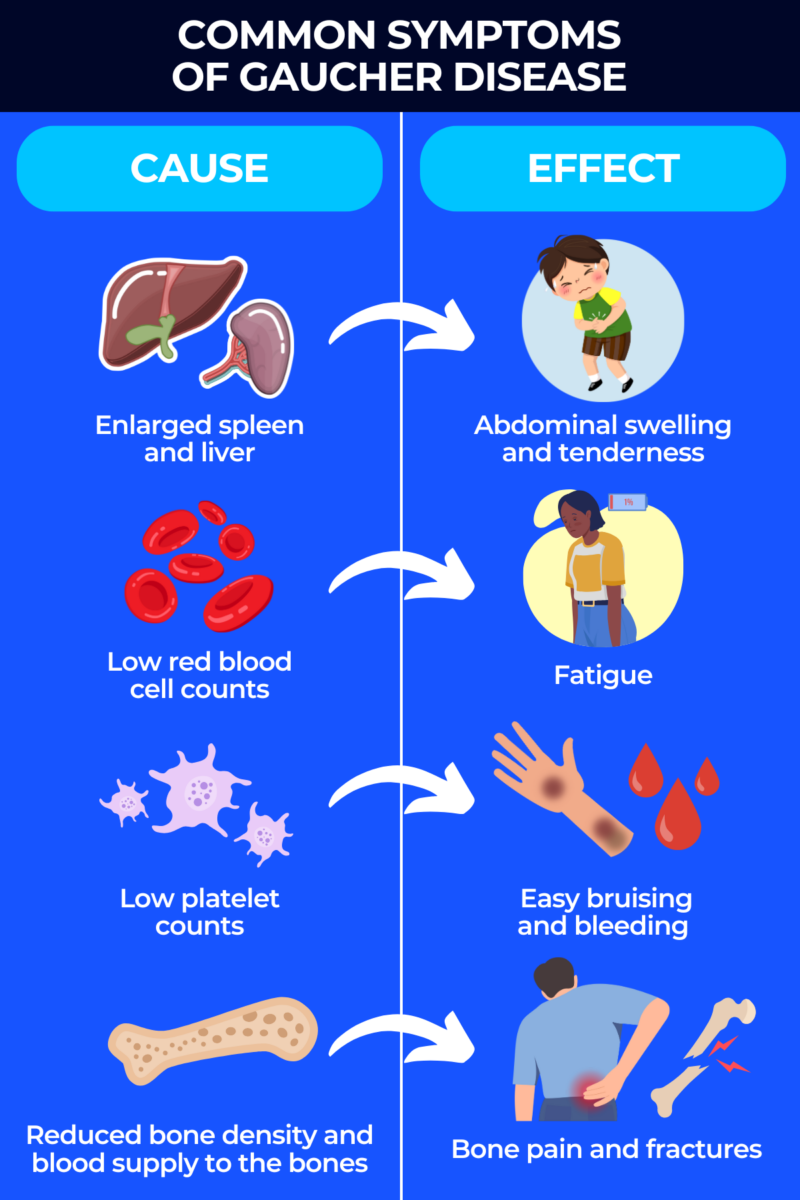
Gaucher disease symptoms
Last updated April 7, 2025, by Marisa Wexler, MS

Gaucher disease is a genetic disorder that can affect many different organs and cause a wide range of symptoms and complications, including enlarged organs, blood disorders, and bone abnormalities. In some cases, neurological complications may also develop.
The specific Gaucher disease symptoms and the age at which they appear vary widely depending on a person’s disease type. However, even people with the same type can present distinct symptoms or different degrees of severity for similar symptoms.
While there is no cure for Gaucher disease, various treatments can help control symptoms and prevent irreversible organ damage. Recognizing the early signs and symptoms of Gaucher disease is therefore essential, as initiating treatment early in the disease course improves outcomes and ensures patients have the best possible quality of life.
Common symptoms of Gaucher disease
Gaucher is caused by mutations in the GBA1 gene, which contains the instructions for producing an enzyme called glucocerebrosidase (GCase). This enzyme helps break down a fatty molecule called glucocerebroside.
In Gaucher disease, reduced GCase function causes this fatty molecule to accumulate to toxic levels in certain cells, mainly in immune cells called macrophages. These enlarged, abnormal macrophages, called Gaucher cells, build up in various organs, leading to damage.
There are three Gaucher disease types, all resulting from mutations in the GBA1 gene. Type 1 is the most common, accounting for about 90% of all Gaucher cases, and it mainly affects the spleen, liver, and bone marrow — organs that are also commonly impacted in types 2 and 3.
The most common signs and symptoms of Gaucher disease arise from damage to those organs and may include:
- abdominal swelling and tenderness due to an enlarged spleen (splenomegaly) and liver (hepatomegaly)
- fatigue or excessive tiredness caused by low red blood cell levels (anemia)
- easy bruising and hard-to-control bleeding due to low levels of platelets that impair blood clotting
- bone problems, such as pain and fractures, due to reduced blood or oxygen supply to the bones.
Neurological symptoms, such as seizures, abnormal eye movements, and cognitive difficulties, are not observed in people with type 1 Gaucher disease, so they aren’t usually considered common symptoms. However, they are present in all patients with types 2 and 3, making them a hallmark of these forms of the disease.

Blood disorders
The buildup of Gaucher cells in the bone marrow, where most blood cells are made, can result in low levels of red blood cells, which are responsible for carrying oxygen through the body, and reduced platelet counts (thrombocytopenia), which are cell fragments that help blood clot.
These issues can be further worsened by an enlarged spleen, which can destroy red blood cells and platelets faster than it should, and also sequester platelets from circulation.
Without treatment, low levels of red blood cells and/or platelets are present in virtually all patients, and can give rise to Gaucher disease signs and symptoms such as:
- fatigue or persistent tiredness and low energy even when well-rested
- frequent or easy bruising
- unusual bleeding, including prolonged bleeding when injured, nosebleeds, bleeding from the gums, and heavy menstrual periods.
People with Gaucher disease also may experience low levels of white blood cells, or leukopenia, which can increase the risk of infection. This complication, however, is less common and rarely requires intervention. Immune dysfunction and frequent infections are most common for infants with Gaucher disease type 2.
Bone-related symptoms
Because Gaucher can disrupt the flow of blood, oxygen, and nutrients to the bones, it often results in bone problems that do not necessarily correlate with the severity of other symptoms. Bone abnormalities, which are observed in about 75%-100% of people with Gaucher type 1, may manifest with signs and symptoms such as:
- bone pain, including severe episodes called “bone crises” that mainly affect the pelvis and lower limbs, due to reduced blood flow to the bones
- decreased bone density, which may be moderate (osteopenia) or more severe (osteoporosis), due to loss of calcium and other minerals
- increased risk of bone fractures, which can occur even without trauma, due to weakened bones
- skeletal abnormalities such as Erlenmeyer flask deformities, where bones become abnormally widened, due to the infiltration of Gaucher cells into the bone marrow
- joint problems and arthritis
- osteonecrosis (also called avascular necrosis or bone infarction) where bone tissue deteriorates and dies, causing significant bone deformities, due to reduced oxygen supply.
Neurological symptoms
Neurological symptoms are not usually seen in Gaucher disease type 1, but are a hallmark of types 2 and 3. For this reason, these two types are also known as neuronopathic Gaucher disease.
Common neurological problems associated with these types of Gaucher disease include:
- abnormal eye movements, such as slowed movement or an inability to move the eyes horizontally
- difficulty swallowing
- seizures
- balance issues and poor coordination
- muscle weakness or stiffness
- cognitive impairment.
While Gaucher disease treatment is available to help manage certain disease symptoms and complications, it is generally not effective for controlling the neurological manifestations of the disease.
Although people with Gaucher disease type 1 do not experience neurological symptoms as a direct result of their disease, some of their symptoms or complications can indirectly give rise to neurological problems — for example, if the spine becomes weakened and compresses nerves in the spinal cord.
Also, regardless of disease type, people with Gaucher may be at increased risk of developing Parkinson’s disease, a neurological disorder marked by movement problems.
Other symptoms of Gaucher disease
Beyond blood problems, bone abnormalities, and neurological issues, other common Gaucher disease symptoms include:
- gaucheroma, a mass of abnormal cells typically found in the liver or spleen
- gallstones, hardened deposits that form in the gallbladder
- metabolic complications, such as diabetes and abnormal levels of cholesterol and triglycerides in the blood.
People with Gaucher disease are also at increased risk of developing myeloma and other blood cancers.
Rare symptoms
There are also many other symptoms that can more rarely occur in people with Gaucher disease. These may include:
- lung problems and trouble breathing, which mostly affect people with Gaucher types 2 or 3
- heart problems, which are most common in some subtypes of Gaucher type 3
- reduced kidney function and presence of blood and protein in urine
- yellowish-brown spots on the skin, usually in the cheeks and lower legs
- giant lymphadenopathy, a condition where lymph nodes become enlarged, mimicking lymphomas
- protein-losing enteropathy, or a loss of protein in the digestive tract, which is most common in Gaucher type 3.
How Gaucher disease symptoms differ by type
Gaucher disease is classically divided into three main types. These are mainly distinguished by:
- the presence or absence of neurological symptoms
- the age at which symptoms first appear
- how fast the symptoms progress.
These types are not absolutes and rather represent a spectrum of how the disease may manifest. There are also more specific subtypes that further help to describe the broad range of symptoms and disease presentations. For example, Gaucher disease type 3c, or cardiovascular Gaucher disease, is a subtype of type 3 that’s marked by heart defects and cardiovascular problems.
Gaucher disease type 1
Gaucher type 1, the most common form of the disease, is also called non-neuronopathic Gaucher because it does not cause neurological problems.
Gaucher disease type 1 symptoms can appear at any age. It’s estimated that around two-thirds of patients will develop symptoms in childhood, with nearly half being diagnosed before age 10. But some patients may not notice any symptoms until adulthood and others with milder variants of the disease may never develop noticeable signs.
Generally, people who develop symptoms earlier tend to have a more severe disease course.
Regardless of the age at disease onset, some of the most common symptoms of Gaucher disease type 1 include spleen and/or liver enlargement, low platelet counts, and anemia.
Other symptoms may be slightly different between children and adults with type 1 Gaucher. For example, about one-third of children have growth delays and delayed puberty. Also, while the vast majority of children have radiological evidence of bone problems, overt bone problems such as bone pain, osteopenia, and fractures tend to be more common in adults.
Despite these complications, with appropriate treatment, people with Gaucher type 1 have a life expectancy that’s close to the general population.
Gaucher disease type 2
Gaucher disease type 2, also called acute neuronopathic Gaucher, is marked by severe neurological complications that manifest shortly after birth, usually between ages 3 and 6 months. Babies commonly present with Gaucher disease early signs such as:
- rigidity in the neck and trunk
- difficulty swallowing
- abnormal eye movements.
Some babies with this type of Gaucher disease may continue to gain skills and achieve developmental milestones, but most will have an impaired development. As the disease progresses, most babies will develop an enlarged spleen with low platelet levels, and about one-third will experience treatment-resistant seizures as part of their Gaucher disease type 2 symptoms.
Due to the severity and rapid progression of the disease, most babies with type 2 Gaucher will die before 2 years of age.
In a particularly severe subtype of type 2, called perinatal-lethal Gaucher disease, babies are usually stillborn or die shortly after birth. This is the rarest type of Gaucher disease.
Gaucher disease type 3
Gaucher disease type 3, also called chronic neuronopathic Gaucher, is also marked by neurological symptoms, but these are less severe and progress more slowly than in type 2.
The disease most commonly develops in young children, with neurological symptoms occurring before age 2 years in about half of cases, but there have been cases of patients developing symptoms in adulthood.
Gaucher disease type 3 symptoms often include abnormal eye movements, seizures, cognitive problems, and poor coordination. Organ enlargement as well as the blood and bone problems seen in type 1 Gaucher are also common in type 3.
Life expectancy for people with Gaucher type 3 is reduced compared with the general population, but patients will often live into their 30s or 40s.
Gaucher Disease News is strictly a news and information website about the disease. It does not provide medical advice, diagnosis, or treatment. This content is not intended to be a substitute for professional medical advice, diagnosis, or treatment. Always seek the advice of your physician or other qualified health provider with any questions you may have regarding a medical condition. Never disregard professional medical advice or delay in seeking it because of something you have read on this website.
Recent Posts
- Bone complications affect most people with Gaucher disease, study finds
- Gaucher treatment doesn’t normalize key biomarker levels
- Constant medical vulnerability can be exhausting
- Understanding genetic factors seen key to personalized therapy
- Researchers uncover seven new genetic variants in Gaucher disease


